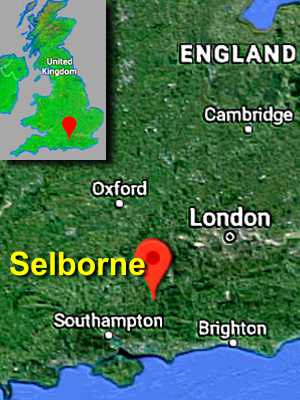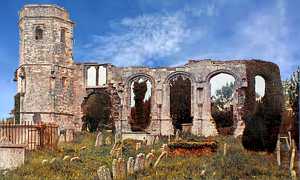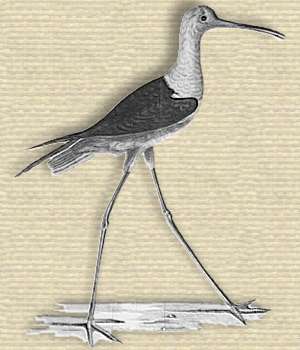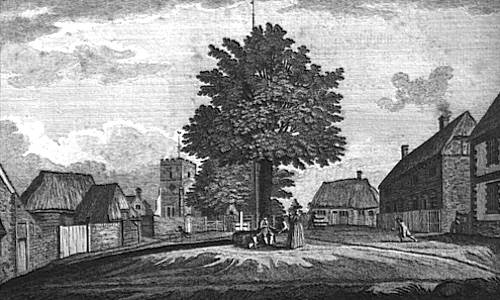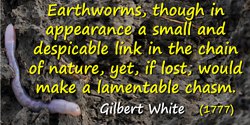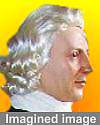 (source)
(source)
|
Gilbert White
(18 Jul 1720 - 26 Jun 1793)
English clergyman and naturalist whose much-loved book, The Natural History and Antiquities of Selbourne, has been continuously in print since it was published in 1789. It contains his extensive, detailed observations of his region's flora and fauna. No authentic picture of White is known. The thumbnail image shown here is from an artist’s imagination for a mannequin representing White on display at Gilbert White’s House.
|
GILBERT WHITE OF SELBORNE.
from Macmillan’s Magazine (1893)
by W. Warde Fowler
[p.182] Gilbert White died … [on] June 26, 1793; the “Natural History and Antiquities of Selborne” was first published four years earlier. Since then many a book of the same type has appeared and disappeared, but White still keeps his hold upon the English mind. Though many may talk of his book without having read it through, and still more may have read it through without discerning its quality, the fact remains that the demand for it is steadily on the increase, and that it is finding its way into the village library and the home of the working man. The name of Gilbert White is a household word with everyone who loves his own incomparable country, with its thousands of villages as homely and as sheltered as Selborne.
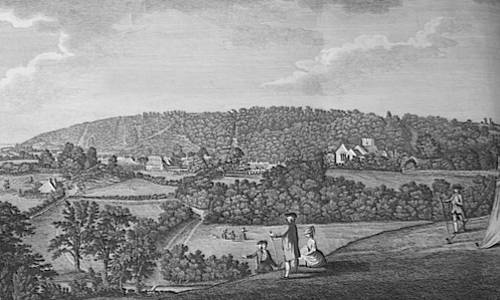
It is strange at first sight that this should be so at a time when we seem passing from a period of poetry and romance into one of stern reality, when the rural population is being drained into the towns, when the squire and the parson are going down in the world, when leisure such as White enjoyed is a rarity and almost a crime, and when the study of economic problems should be driving out of our heads the delights of wild nature or of sport. But the Englishman has always been a strange and self-contradictory creature. With all his commercial instincts and his town- bred vulgarity, his phases of stern Puritanism and political excitement, he has never yet lost that love of the country which is rooted in the life of the manor and the village. Even with the American the same passion still lives; he took it with him to New England in the seventeenth century, and the books of Mr. John Burroughs and Miss Mary Wilkins have lately made us aware how strongly it survives in him in the nineteenth.
Surely the spread of the factory system, and the consequent growth of huge towns, has rather strengthened than weakened this love of all things rural. We pine for pure air, for the sight of growing grass, for the footpath across the meadow, for the stile that invites you to rest before you drop into the deep lane under the hazels. But in the last century there was no need to pine, when there was hardly a town from which a man could not escape into the fields when he would, without toiling through grimy suburbs where the problems of economic science force themselves at every turn on his mind. In those days men loved the country simply as their home, not because they were shut away from it; they took it as a matter of course, and seldom wrote about it. Now we mingle a touch of self-consciousness in our passion for it, which finds its expression in a multitude of books.
What a literature of the fields has sprung up, since the “Natural History of Selborne” was first published! Not to mention the poets, from our novelists we seem almost to demand the familiar descriptive background, careless too often whether they are mere daubs, or the work of a master such as Mr. Blackmore or Mr. Hardy. And then again there is an ever-increasing call for books whose whole intention is to open our wayward eyes to country sights and sounds. Since the days of White we have had Knapp, Howitt, Jesse, Knox, Wood, and others who are still readable and still read; and later, and in a higher region of literature, we have had Kingsley, Jefferies, and Mr. Hammerton. To-day a score of books of the same type are published [p.183] every year; and good and bad alike seem to find abundant readers. The Selborne Society has spread all over the land; most of our public schools boast of a Natural History Society, which has taken root in the very citadel of athleticism, and effectually holds its own, issuing its report yearly. Neither athletics nor examinations can kill the old instinct of Englishmen; it is as strong as ever, and the scientific spirit of the age has given it a useful turn.
All this literature of the country, all this youthful endeavour, may be traced back not only to the natural instincts of the English country gentleman, like so many other institutions of ours, but to the work of the first country gentleman who could shake himself free from the tyranny of books, and describe what he saw around him in simple and engaging English. White’s book has taken possession of the English mind as securely as the “Complete Angler,” or even as “Robinson Crusoe.” At the distance of a century one may well ask why this is so, and what has given the book its enduring quality. This I will try to do; but first I must say a word of the man himself, for I think it is in one characteristic of his, and one that in these days some might call a weakness, that the secret of his fame is to be found.
He was born in 1720 at the village which will always be associated with his name, and in which he spent almost the whole of his long life. The connection of his family with Selborne was however an accidental one. His grandfather, after whom he was named Gilbert, was a Fellow of Magdalen College, Oxford, and was presented by the College to the living of Selborne in 1681. This Gilbert White was apparently a well-to-do man, for he left considerable bequests to the village, and doubtless inherited wealth from his father, who had been an eminent citizen of Oxford in the time of Cromwell. Sampson White, whom we may call the founder of the family, was a draper in the High Street; he had migrated to the city from Coggs near Witney, where his family had been settled for many generations. He was Mayor in 1660, and served as “butler of the beer-cellar” at the coronation of Charles II., and was knighted among many others at that gay time. Thus I may claim the recluse of Selborne as in some sort an Oxfordshire man. But that his own Hampshire folk may have their due, I must add that not only was his grandmother a Hampshire lady, but, if Anthony Wood is to be trusted, the family was “originally descended from the Whites of South Warnborough in Hampshire.”1 Apparently the love of village life was strong in the family; for John, son of Gilbert the Vicar, settled down in Selborne after his father’s death, as a country gentleman of some property, married, and had several sons by a Miss Holt of Streatham. He could afford to give his sons a good education, for he sent Gilbert to a tutor at Basingstoke who was himself a scholar, and who knew how to bring up his sons as scholars. Both these boys were younger than Gilbert; the elder one, Joseph Warton, matriculated in the same year with him at Oriel, and became afterwards Head Master of Winchester; while the younger, Thomas, the friend of Johnson, was afterwards Fellow of Trinity and Professor of poetry. Of these schooldays we know only one incident, told us by White himself in his letters on the antiquities of Selborne. “When a schoolboy, more than fifty years ago, he [the author] was an eyewitness, perhaps a party concerned, in the undermining of that fine old ruin at the north end of Basingstoke town, [p.184] well known by the name of Holy Ghost Chapel.” Any one who will read the rest of the passage, will see that even in his old age White could dwell with some complacency on this exploit. With a quiet humour, only possible in an age that knew no “society for the preservation of ancient buildings,” he quotes Dryden:
But the history of White’s early years is lost almost as completely as the memory of his features, of which no portrait seems to be in existence. Doubtless he was an animal-loving and bird-nesting boy, and acquired an observant habit without knowing it; but I doubt if he began any systematic study of natural history till he settled down at Selborne. He often refers to his earlier sporting days, and it is likely enough that it was only when sport began to fail him that he set about that minute attention to animal life that has chiefly made him famous as a naturalist. But under Mr. Warton his sporting instincts must have been kept under due control. He became a scholar, as scholarship was then: he read the Latin poets, and learnt to love and quote them; and when he went to Oriel in his nineteenth year he was sufficiently equipped with learning to be eventually elected Fellow.
His Fellowship began early in 1744, and he held it until his death almost fifty years later. As a Fellow he was of course ordained, and later on he took a small college living in Northamptonshire; but he took it on the understanding that he should never reside there, and to this resolution, which in these days seems shocking, he steadily adhered all his life. I do not wish to dwell on this, or on his other relations to his college, which were not wholly of a pleasant character; but Oxford men are aware that a non resident who insists on his right to take his turn as Proctor, or who holds his Fellowship for fifty years, is not likely to be popular with his college. Yet in Dr. Bell’s edition of the “Natural History of Selborne” we have such irresistible evidence of White’s kindness of heart and charm of manner as can hardly be reconciled with Mr. Shadwell’s severe verdict in his account of the history of Oriel.2
The fact seems to be that the age was a self-indulgent one, and that Oxford was not the place to correct the tendency in a man whose mind was beginning to be ruled by one overmastering motive. Life and leisure in his native village were what White longed for, and it is to his indulgence of this longing that we owe his immortal book. This weakness, if such it be, is the clue to his character, and to the excellence of his work as well as to its shortcomings. Happy, amiable, observant at Selborne, he was perhaps too much discomposed at leaving it to be altogether himself elsewhere. For such close and keen observation as his, it is really necessary to be master of one’s own time, to be absolutely free from hurry and interruption, and this, not only that a bird or insect may be carefully watched, but that what is seen may sink quietly and surely into the mind. Few men have enjoyed such leisure, and few indeed have been so well qualified to use it fruitfully. In our own day Darwin is a familiar instance, and it is interesting to find in him too, in his later years, the same discomposure at leaving home, the same unconquerable love of his own home life. I have sometimes felt almost exasperated that White has nothing to tell us of his occupations at Oxford,—nothing of the animal life that cannot have been less abundant round the city in his day than it is now. But he was White of Selborne, not White of [p.185] Oxford. If natural history has lost anything by his want of adventure, it has after all gained more; for the unique value of his book is mainly due to the persistence with which he followed his own instinct, and to the complete ease and isolation in which his acute mind worked at home.
To this ease and isolation,—the complete absence of hurry and worry,—we may attribute indeed not only the scientific value of his observations, but the perfection of the form in which he was able to record them. How leisurely his life was, we may see if we consider the fact that he did not publish his book until he was close upon seventy, and that the letters which compose it were spread over a long period of years. During the last forty years of his life he did not often leave home, and when he did leave it, never went far or for long. There was a definite work for him to do at Selborne, and though he could have hardly realised the importance of the lesson he was giving to English naturalists, he could justify this gratification of his natural instincts on excellent grounds. Let me quote his own words. “Though there is endless room for observation in the field of nature, which is boundless, yet investigation, where a man endeavours to be sure of his facts, can make but slow progress; and all that one could collect in many years would go into a very small compass.” Or again: “Men that undertake only one district are much more likely to advance natural knowledge than those that grasp at more than they can possibly be acquainted with; every kingdom, every province, should have its own monographer.”
The full force of sentences like these can hardly be felt by one who merely reads White’s book in the light of our modern knowledge. They are indeed invaluable warnings for all time, and every man who puts pen to paper to write on natural history might do well to learn them by heart. But we must remember that in his day the accurate study of the life and habits of animals was almost unknown, and that facts which are now the common property of naturalists were then awaiting discovery or verification. If, for example, we take his favourite study of ornithology, it is at first astonishing to find that for a whole century before his book was published no Englishman had made any important contribution to the science. So far as England was concerned, White had to take it up almost exactly where Willughby and Ray had left it. And if we open Willughby’s book, published by his friend Ray in 1678, and turn to his account of any of the insignificant-looking little birds that swarm in our woods and fields, we shall find that the study of their songs, habits, and movements, had then hardly begun, and that the scientific mind was still to a great extent under the tyranny of books and traditions. Willughby’s is a great name, and had he not died young, he might have settled down in England to a leisurely study of the living birds; but he seems to have been in temperament the very opposite of White, and his short life was mainly spent in foreign travel. The work was still waiting for the man who would not travel, whose curiosity was indeed unbounded, but fortunately kept under control by the overpowering love of home. “It is now more than forty years,” White wrote in 1779, “that I have paid some attention to the ornithology of this district, without being able to exhaust the subject; new occurrences still arise as long as any inquiries are kept alive.”
It would be quite superfluous to give illustrations of the closeness and acuteness of White’s observation of birds. We need but open the book at random,—or if we would study some one letter as a model both of matter and manner, we may turn to one of those famous and familiar ones which treat of the habits of the swallow tribe, and bearing in mind how little was really known of these [p.186] birds in his day, take in paragraph after paragraph with just such care and close attention as he himself bestowed on his favourites. White must never be read in a hurry; we must take his book in the spirit in which it was written. There is a favourite phrase of his which exactly expresses that spirit. We should read it, as it was written, with a nice observation and discernment. Though I said that it is superfluous to quote, I cannot refrain from the pleasure of copying a single short paragraph by way of illustrating this “niceness” of his; I alight on it at random, and it strikes me as giving us a little picture of the man himself at his work, satiating his unlimited curiosity, and bringing the large range of his knowledge to bear on the examination of some special point.
At some certain times in the summer I had remarked that swifts were hawking very low for hours together over pools and streams; and could not help inquiring into the object of their pursuit that induced them to descend so much below their usual range. After some trouble, I found that they were taking Phryganeæ Ephemeræ, and Libellulæ (cadew-flies, may-flies, and dragon-flies), that were just emerged out of their aurelia state. I then no longer wondered that they should be so willing to stoop for a prey that afforded them such plentiful and succulent nourishment.
This passage may aptly remind us that White was by no means only an ornithologist. It is true that many of the most exact and enduring of his observations were made on birds, for birds were always about him, and it is clear that he loved them best. There is not a writer on birds but has drawn on him,—with or without acknowledgment,—for the history of the stone-curlew, the ring-ousel, the house-martin, the sand-martin, the goatsucker*, and many more; and where he did not get far himself he threw out hints “in order to set the inquisitive and discerning to work.” But to him not only birds, but every living and growing thing was a delight and a mystery. The words I have just quoted occur in a very brief letter to Barrington on earthworms, which is an excellent example of the true.nature and value of his work as a whole. “A good monography of worms” he says, “would afford much entertainment and information at the same time, and would open a new and large field in natural history.” This letter was written in 1777; just sixty years later Darwin read his first paper on this subject to the Linnaean Society, and we had to wait nearly another half century before the monograph at last appeared. I do not know whether Darwin’s long series of observations were originally suggested by this remark of White’s, but I am strongly tempted to fancy that it must have been so. Darwin at least remembered White’s letter, and quotes it as showing his accuracy on a point of detail often misapprehended. White’s keen eye, and his habit of thinking leisurely about what he saw, did in fact enable him to seize on the great secret of worm-economy which Darwin probed with such marvellous and patient persistence. “Earthworms, though in appearance a small and despicable link in the economy of nature, yet if lost, would make a lamentable chasm. Worms probably provide new soil for hills and slopes where the rain washes the earth away; and they affect slopes probably to avoid being flooded.” But the whole letter occupies little more than a page. It was not in White’s nature to investigate such a subject thoroughly, though it was one which might have been pursued without the aid of modern science. He was a pioneer, and would never for a moment have thought of himself as a great naturalist. But it would be hard to say how many of the discoveries of the nineteenth century may not have sprung from seed which he so freely scattered. To mention one more instance, he was the first naturalist, so far as I know, to notice that “protective mimicry” in the habits of animals the study of which has become so popular [p.187] and so fruitful at the present day. Just as but lately I observed how some tiny partridges, which I had disturbed, ran and thrust their heads into the first patch of brown grass they could find, so White more than a century ago noticed that the young of the stone-curlew skulk among the stones of some flinty field, “which are their best security, for their feathers are so exactly of the colour of our grey spotted flints, that the most exact observer, unless he catches the eye of the young bird, may be eluded.”
One unconsciously strays back to birds in talking of White; but his notes range over the whole field of the animal and vegetable life of his district. We all remember the tortoise at Ringmer, which after many years’ acquaintance became his guest and friend at Selborne; the field crickets at the “Short Lithe” behind the village, which eluded his efforts to domesticate them in his garden; the little harvest mouse which he was the first to describe, and whose “procreant cradle” was rolled across his table,—perhaps the very table that now stands in the Common Room of Oriel College— without discomposing the eight naked and blind little inmates. Trees, too, were the objects of his particular affection, though he for the most part left botany to the specialist. Insects he evidently studied with great care; and here again he makes a suggestion which has only of late been seriously taken up, influenced by a conviction, of which several proofs may be found in his book, that the study of nature may and should be made to be of direct practical value to mankind. “A full history of noxious insects hurtful in the field, suggesting all the known and likely means of destroying them, would be a most useful and important work. A knowledge of the properties, economy, propagation, and in short of the life and conversation of these animals, is a necessary step to lead us to some method of preventing their depredations.”
Though his records are confined to his own district, White’s conception of the work of the naturalist was as broad and rational as that of Aristotle. He took mankind into his view, and nothing escaped him that was worth recording of the economy, the superstitions, the language, of the people who lived around him. One of his best letters is devoted entirely to the subject of rush candles and their manufacture; and we have in another some acute reflections on the disappearance of leprosy in England. And it is. most important to remember, if we would judge his book as he would himself have wished it to be judged, that by natural history he understood not only the study of animals and plants, but the study of all natural productions and occurrences,—of every natural phenomenon, that is, which was brought to his notice in his neighbourhood. In the advertisement to the first edition he makes it clear that he considered himself to have made an attempt to give the public an idea of what parochial history should be, and to have tried to lend a helping hand towards “the enlargement of the boundaries of historical and topographical knowledge.” In the “Antiquities of Selborne,” issued originally together with the Natural History, he showed that he had a remarkably just sense of what was worth recording, and how it should be recorded. The documents that he accurately transcribed relating to the Priory of Selborne are of real historical value, more especially the account of the visitation by William of Wykeham in 1387. Even now the example he set might serve as a model for village antiquaries; for the professed antiquary is often a pedant, and limits his interests and inquiries to the most prominent buildings and their history. White’s mind was fresh and bright in old age as in youth, his tastes were human and catholic; and the history of the works of man in Selborne was for him only a part of what the parish had to contribute to the whole sum of human knowledge.
[p.188] A word must needs be said about the literary quality of White’s book. It is interesting here again to find that the ease and isolation of his life had a marked influence on the form into which he threw his thoughts and observations. In the latter part of his life, as we have seen, he rarely left the beloved village; but in spite of his local isolation, he kept himself well acquainted with what was doing in the world of science, both by the purchase of books and by frequent correspondence with friends. He had no neighbours of his own tastes, and it became all the more necessary for him to make the most of friends at a distance. Now it was part of the singular good fortune of his whole life that he had no less than four brothers, all with tastes suited to his own; two at least of these were good naturalists, and another became the most noted publisher of his day in the department of natural history. John settled at Gibraltar, and is often mentioned by Gilbert as sending him valuable information; Thomas became a Fellow of the Royal Society, and a writer of some note; Benjamin was the publisher of his brother Gilbert’s book. Brothers are not usually good correspondents, but the spell of the Hampshire home never failed in holding this wonderful family together. Long before he began his more elaborate correspondence with men of greater renown, Gilbert must have fallen into the way of compressing his accounts of home and Selborne within the limits of the old-fashioned letter-sheet; and as letters were then in vogue in literature, it was only natural that when he was at last persuaded to publish, he should keep to the form in which he had all through life been accustomed to express his thoughts. And we cannot be too thankful that here, as always, he followed his natural instincts.
The letters to Pennant and Barrington, doubtless revised carefully for publication, must have been originally written with greater care and attention than he would bestow on his brothers’, for both correspondents were men of mark in the literary and scientific world. Pennant was the most voluminous writer of his time; Barrington was a strange compound of lawyer, antiquary, and naturalist. To them no doubt White was at first an interesting and useful curiosity, and in his eyes they were great figures, men who had published books and knew the great world beyond Selborne. But whether his correspondents were great men or small, White could not but write to them in his own happy way. There is not a pompous or affected sentence in all these letters, which number exactly a hundred. The influence of the age on his language is of course visible enough, but he is always simple and natural, never lofty or pedantic. Compared with many later writers on the same subjects, he is a classic. He calls a spade a spade, and never affects fine writing; with him a bird flies, instead, of “winging its way,” as some ornithological authors will have it.
Oddly enough the only overweighted sentence I can discover was probably the last one he wrote for the book. Prefaces often give their writers much trouble, and in the last sentence of his preface White’s pen seems for once to have stuck fast. It shows us very plainly that he was here out of his natural element; but it may well have pleased the “circle of gentlemen whose intelligent communications, as they have afforded him much pleasing information, so, could he flatter himself with a continuation of them, would they ever be deemed a matter of singular satisfaction and improvement.” After all, this preface is brief enough, and itself marks his steady adherence to the maxim of Linnaeus which he quotes elsewhere with approval, “Verbositas hujus sæculi calamitas artis.”**
The enduring popularity of the letters is however due not only to [p.189] their brevity, variety, and accuracy, but in great part to the little felicities and quaintnesses of expression in which they abound. Every bird- lover remembers the “sibilous shivering noise” of the wood-wren, and the “full, sweet, deep, loud, and wild pipe” of the blackcap. Sometimes we get an unusual word used with rare effect, as when the tame raven, kenning the toad as he put forth his head, gave him such a severe stroke with his beak as put out one eye. Sometimes it is an ordinary word that is used in a sense which to us at least is fresh and telling. “The life and conversation“ of the birds occurs more than once, and more than once too we hear of “delicate” weather. Occasionally we come across an old word in a new sense, with perhaps a touch of humour lurking in it, as when we are told that the tortoise has an “arbitrary” stomach, and can refrain from eating during a great part of the year. That White had a strong sense of humour is beyond a doubt, for it comes out clearly enough in the more chatty private letters which have been published in recent years;3 but in those to his distinguished correspondents he indulges it rarely and very quietly. Once, in one of the later letters to Barrington, he could not resist the temptation, and thus describes the aspect of the hens when a hawk, captive and disarmed, was placed in their yard. “Imagination cannot paint the scene that ensued ; the expressions that fear, rage, and revenge inspired, were new, or such as had been unnoticed before; the exasperated matrons upbraided, they execrated, they insulted, they triumphed.”
But Gilbert White’s book needs no introduction or comment. Every one, young or old, can see for himself, that, in the language he uses of his own chalk hills, there is something “peculiarly sweet and amusing” in its shapely letters. Of himself we know little; he would never sit for his portrait, and from such tradition as has come down to us, we can only imagine a little upright man with a keen eye and complacent expression, and probably with a strong common sense and practical turn of mind, quite ready to assert himself where he thought he had a right, but also quite unwilling to push himself into notice in a world where he was not at home. Still, if we are really to know anything worth knowing about him, we must go to his book, and read it again and again; and it will always charm us with the same lesson of keen and sympathetic insight into nature, of perfect candour in reasoning, and of admirable taste in expression. Sentimentality and pedantry are alike absent from it; where he feels tenderly he rather hints it than expresses it, and when his scholarship induces him to quote a line of Virgil, he invariably hits the mark with it. As a man he must have had his faults, but as the writer of his one book he assuredly came very near to perfection.
2 See “The Colleges of Oxford,” edited by Rev. A. Clark, p. 121. It is only fair to White to add that for the greater part of his life at Selborne he held curacies, either there or at a neighbouring village.
3 More especially in the letter to Miss Malso from Timothy the Selborne tortoise, ending “ Your affectionate reptile,” which will be found in the second volume of Dr. Bell’s edition.
[Webmaster notes: * Also known as nightjar or nighthawk; ** Verbosity, this time wasting art. (translation by Webmaster). There is no known portrait of Gilbert White, so the thumbnail image used is of a mannequin created from an artist’s imagination for a Gilbert White exhibit. William Warde Fowler, a historian at Oxford, was himself an ornithologist, and wrote books about birds. The village of Selborne is in the English county of Hampshire, and within the South Downs National Park.]
- Science Quotes by Gilbert White.
- 18 Jul - short biography, births, deaths and events on date of White's birth.
- Gilbert White - short biography of the naturalist.
- The Natural History of Selborne, by Gilbert White. - book suggestion.
